
Agaricus is a genus of mushrooms containing both edible and poisonous species, with possibly over 300 members worldwide. The genus includes the common ("button") mushroom and the field mushroom, the dominant cultivated mushrooms of the West.
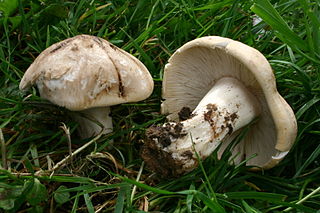
Calocybe gambosa, commonly known as St. George's mushroom, is an edible mushroom that grows mainly in fields, grass verges and roadsides. Deriving its common name from when it first appears in the UK, namely on St George's Day. It appears in March in Italy, a warmer country where it is also a popular mushroom to eat, and is known there as marzolino. It is also popular in Northern Spain and Southern France, in the Basque Country region and its surroundings where it appears in April. In these regions it is usually eaten sautéed with egg or with bacon.
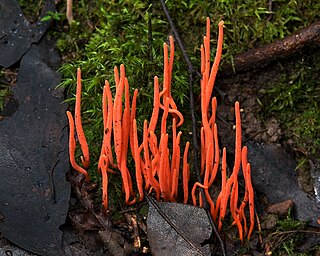
The Clavariaceae are a family of fungi in the order Agaricales. Collectively, they are commonly known as coral fungi due to their resemblance to aquatic coral, although other vernacular names including antler fungi, finger fungi, worm mold, and spaghetti mushroom are sometimes used for similar reasons.

Ryan Henk Donk is a Dutch professional footballer who plays as a midfielder for Turkish club Galatasaray. He can also play as a centre back.

Cuphophyllus is a genus of agaric fungi in the family Hygrophoraceae. Cuphophyllus species belong to a group known as waxcaps in English, sometimes also waxy caps in North America or waxgills in New Zealand. The genus was described by French mycologist Marcel Bon in 1985. It is synonymized with Hygrocybe by some authorities, although recent molecular evidence confirms its validity as a distinct genus.
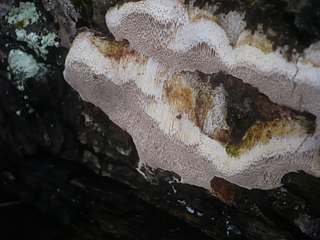
Perenniporia medulla-panis is a species of poroid fungus in the family Polyporaceae. It is a plant pathogen that infects stone fruit trees. The species was first described by Nikolaus Joseph von Jacquin in 1778. Marinus Anton Donk transferred it to the genus Perenniporia in 1967.

The Hydnaceae are a family of fungi in the order Cantharellales. Originally the family encompassed all species of fungi that produced basidiocarps having a hymenium consisting of slender, downward-hanging tapering extensions referred to as "spines" or "teeth", whether they were related or not. This artificial but often useful grouping is now more generally called the hydnoid or tooth fungi. In the strict, modern sense, the Hydnaceae are limited to the genus Hydnum and related genera, with basidiocarps having a toothed or poroid hymenium. Species in the family are ectomycorrhizal, forming a mutually beneficial relationship with the roots of trees and other plants. Hydnum repandum is an edible species, commercially collected in some countries and often marketed under the French name pied de mouton.

Peniophora is a genus of fungi which are plant pathogens. Members of the genus belong to the class Agaricomycetes, order Russulales, and family Peniophoraceae. The genus is widespread, and contains 62 species. The species of Peniophora are resupinate, or crust-like, and are described as corticioid. A number of its members are parasitised by other fungi. For example, Tremella mesenterica is a parasite to several species of Peniophora.
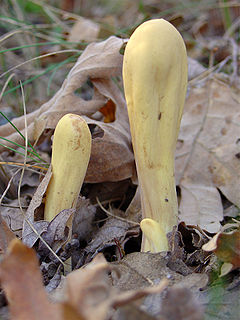
Clavariadelphus is a genus of club fungi in the family Clavariadelphaceae. The genus has a widespread distribution in temperate areas, and contains an estimated 19 species. The name might mean uterus-shaped club, from the Latin clava meaning club and the Greek delphus meaning uterus.
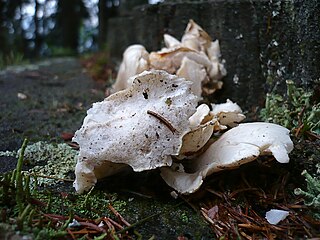
Osteina is a fungal genus in the family Fomitopsidaceae. It is a monotypic genus that contains the single species Osteina obducta. The genus was circumscribed by mycologist Marinus Anton Donk in 1966, with Polyporus obductus as the type species.

Hyphoderma is a genus of crust fungi in the family Meruliaceae. It was circumscribed by German botanist Karl Friedrich Wilhelm Wallroth in 1833.
Episphaeria is a genus of fungus in the Agaricales. The genus is monotypic, and contains the single rare species Episphaeria fraxinicola, found in Europe. Its familial position is not known with certainty. The tiny fruit bodies of the fungus resemble minute, white cups that grow scattered or in groups on the bark of ash trees.

The clavarioid fungi are a group of fungi in the Basidiomycota typically having erect, simple or branched basidiocarps that are formed on the ground, on decaying vegetation, or on dead wood. They are colloquially called club fungi and coral fungi. Originally such fungi were referred to the genus Clavaria, but it is now known that clavarioid species are not all closely related. Since they are often studied as a group, it is convenient to retain the informal (non-taxonomic) name of "clavarioid fungi" and this term is frequently used in research papers.

The cyphelloid fungi are a group of fungi in the Basidiomycota that have disc-, tube-, or cup-shaped basidiocarps, resembling species of discomycetes in the Ascomycota. They were originally referred to the genus Cyphella and subsequently to the family Cyphellaceae, but are now known to be much more diverse and are spread through several different genera and families. Since they are often studied as a group, it is convenient to call them by the informal (non-taxonomic) name of "cyphelloid fungi". Better known cyphelloid genera include Calyptella, with stalked, cup- or bell-like fruit bodies; Lachnella, with conspicuous, hairy-margined, disc-like fruit bodies; Flagelloscypha with smaller, but equally hairy, cup-like fruit bodies; Henningsomyces with tube-like fruit bodies; and Merismodes with clustered, hairy, cup-like fruit bodies.
Marinus Anton Donk was a Dutch mycologist. He specialized in the taxonomy and nomenclature of mushrooms. Rolf Singer wrote in his obituary that he was "one of the most outstanding figures of contemporary mycology."

Tephrocybe rancida is a species of fungus in the family Lyophyllaceae. It was first described by Swedish mycologist Elias Magnus Fries in 1821. T.rancida is commonly called the Rancid Greyling due to its typical coloring and rancid smell and taste.
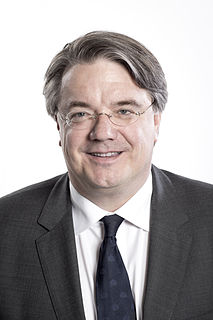
Wilhelmus Bernhard Henricus Josephus "Wim" van de Donk is a Dutch politician and former academic serving as the King's Commissioner of North Brabant since 1 October 2009. He is a member of the Christian Democratic Appeal.

Daniëlle van de Donk is a Dutch professional footballer who plays as a midfielder and a winger for Arsenal in the FA WSL and The Netherlands national football team.

Dentipratulum is a genus of fungi in the family Hericiaceae. It was circumscribed by Dutch mycologist Marinus Anton Donk in 1962. Species in the genus have membranous fruit bodies that are either completely resupinate or effuso-reflexed. The hymenium bears "teeth".

The Irpicaceae are a family of mostly polypores and crust fungi in the order Polyporales.


















